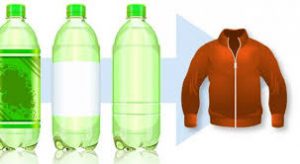Not all products are recycled in the same way, but they are recycled for the same basic reasons:
 to preserve the earth’s natural resources, such as precious metals, minerals, and wood
to preserve the earth’s natural resources, such as precious metals, minerals, and wood- to reduce the need to landfill and incinerate
- to cut down on air and water pollution, and to reduce the emission of green house gasses
- to save energy
Recycling can be divided into two types: closed loop and open loop. Which recycling approach is used depends on the materials in the product itself.
Closed Loop Recycling
Closed loop recycling means 100% of a product can be recycled over and over again. Recycling aluminum cans into aluminum cans is the most common example of closed loop recycling. No  new raw materials have to be introduced into the “recycling loop” and no unusable materials have to leave the loop as waste. It is obvious that closed loop recycling is the more earth friendly, sustainable system. Unfortunately very few things, even metals, can be recycled this way. That is why most of our recycling today is actually open loop recycling.
new raw materials have to be introduced into the “recycling loop” and no unusable materials have to leave the loop as waste. It is obvious that closed loop recycling is the more earth friendly, sustainable system. Unfortunately very few things, even metals, can be recycled this way. That is why most of our recycling today is actually open loop recycling.
Open Loop Recycling
Open loop recycling means a product can be broken down and its useful materials extracted and used to create a new, different product.  The most familiar example of this is recycled plastic bottles being made into fleece fabric for jackets. This process is considered “open” because the fleece jacket made from the recycled bottles can’t be recycled again and will eventually have to” leave the loop” and wind up as waste in a landfill or incinerator.
The most familiar example of this is recycled plastic bottles being made into fleece fabric for jackets. This process is considered “open” because the fleece jacket made from the recycled bottles can’t be recycled again and will eventually have to” leave the loop” and wind up as waste in a landfill or incinerator.
Benefits of Both
With closed loop recycling, zero waste goals are met, but that doesn’t mean if something can’t be recycled 100%, there is no value proposition. Open loop recycling is better than no recycling. It reuses precious raw materials and delays waste going to landfills and incinerators. Most recycling has to be open loop because, among other reasons, many materials degrade in quality during the recycling process, and some recycled metals need to be mixed in with primary metals to meet manufacturing requirements.
Do you know any products that are recycled in a closed loop? Please share any ideas you have or leave your suggestions and comments below…